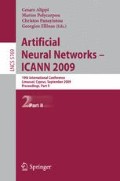Abstract
This paper presents an application of multiple kernels like Kernel Basis to the Relevance Vector Machine algorithm. The framework of kernel machines has been a source of many works concerning the merge of various kernels to build the solution. Within these approaches, Kernel Basis is able to combine both local and global kernels. The interest of such approach resides in the ability to deal with a large kind of tasks in the field of model selection, for example the feature selection. We propose here an application of RVM-KB to a feature selection problem, for which all data are decomposed into a set of kernels so that all points of the learning set correspond to a single feature of one data. The final result is the selection of the main features through the relevance vectors selection.
Access this chapter
Tax calculation will be finalised at checkout
Purchases are for personal use only
Preview
Unable to display preview. Download preview PDF.
References
Bach, F.R., Lanckriet, G.R.G., Jordan, M.I.: Multiple kernel learning, conic duality, and the smo algorithm. In: ICML 2004: Proceedings of the twenty-first international conference on Machine learning, p. 6. ACM Press, New York (2004)
Efron, B., Hastie, T., Johnstone, I., Tibshirani, R.: Least angle regression, pp. 407–499 (January 2003)
Girolami, M., Rogers, S.: Hierarchic bayesian models for kernel learning. In: 22nd International Conference on Machine Learning, pp. 241–248 (2005)
Guigue, V., Rakotomamonjy, A., Canu, S.: Kernel basis pursuit. In: CAP, pp. 93–106 (2005)
Gunn, S., Kandola, J.: Structural modelling with sparse kernels. Machine Learning 48, 137–163 (2002)
Mackay, D.J.: Probable networks and plausible predictions - a review of pratictal bayesian methods for supervised neural networks, vol. 6, pp. 469–505 (1995)
Mika, S., Rätsch, G., Weston, J., Schölkopf, B., Smola, A.J., Mueller, K.-R.: Constructing descriptive and discriminative non-linear features: Rayleigh coefficients in kernel feature spaces. IEEE Transactions on Pattern Analysis and Machine Intelligence (2004)
Rakotomamonjy, A., Bach, F., Canu, S., Grandvalet, Y.: Simple MKL. Journal of Machine Learning Research (2008)
Schölkopf, B., Smola, A.J.: Learning with Kernels. MIT Press, Cambridge (2002)
Suard, F., Rakotomamonjy, A., Bensrhair, A.: Model selection in pedestrian detection using multiple kernel learning. In: Intelligent Vehicles Symposium 2007, Istanbul (June 2007)
Tipping, M.: The relevance vector machine. In: Solla, T.K.L.S.A., Müller, K.-R. (eds.) Advances in Neural Information Processing Systems, vol. 12. MIT Press, Cambridge (2000)
Vapnik, V.: The Nature of Statistical Learning Theory. Springer, N.Y. (1995)
Vincent, P., Bengio, Y.: Kernel matching pursuit. Mach. Learn. 48(1-3), 165–187 (2002)
Wu, L., Schölkopf, B., Bakir, G.: A direct method for building sparse kernel learning algorithms. Journal of Machine Learning Research 7, 603–624 (2006)
Author information
Authors and Affiliations
Editor information
Editors and Affiliations
Rights and permissions
Copyright information
© 2009 Springer-Verlag Berlin Heidelberg
About this paper
Cite this paper
Suard, F., Mercier, D. (2009). Using Kernel Basis with Relevance Vector Machine for Feature Selection. In: Alippi, C., Polycarpou, M., Panayiotou, C., Ellinas, G. (eds) Artificial Neural Networks – ICANN 2009. ICANN 2009. Lecture Notes in Computer Science, vol 5769. Springer, Berlin, Heidelberg. https://doi.org/10.1007/978-3-642-04277-5_26
Download citation
DOI: https://doi.org/10.1007/978-3-642-04277-5_26
Publisher Name: Springer, Berlin, Heidelberg
Print ISBN: 978-3-642-04276-8
Online ISBN: 978-3-642-04277-5
eBook Packages: Computer ScienceComputer Science (R0)

